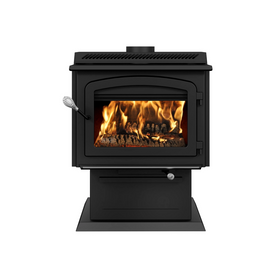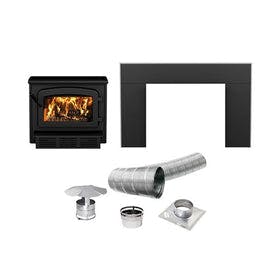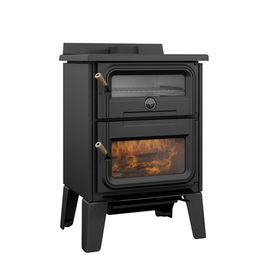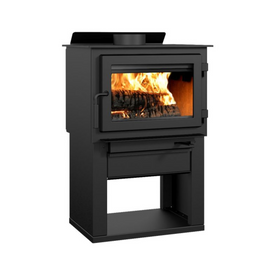- Home
Is Heating Your Home With Wood Bad for the Environment?
Unlike fossil fuels, burning wood or biomass for heat or home energy is considered to be carbon-neutral. Wood and biomass come from plants that suck carbon dioxide out of the atmosphere during their growth. While that carbon dioxide is re-released during burning (or during natural decomposition), this is part of a natural cycle and doesn’t contribute to increasing levels of carbon dioxide and other greenhouse gases in our atmosphere.
Wood pellets are one popular biomass alternative for home heating. A wood pellet stove will help you avoid having to split an enormous amount of firewood on a cold winter morning and can also reduce the number of trees harvested for fuel. Below, we offer a complete review of the pros and cons of opting for wood pellets for your home heating needs.
The Problems with Scaling Up Use of Conventional Wood Stoves
Wood stoves offer an efficient, economical, and sustainable way to heat your home. However, it is essential to note that if everyone in the country started relying on firewood for their primary heating needs, the pressure on standing forests would drastically increase. There are around 128 million households in the United States. Families that rely on wood heating for their primary heating needs average about four firewood cords per winter.
According to the University of Illinois Extension Service, one full-size tree with a “diameter breast height” of 22 inches will produce one full cord of firewood. If every household in the United States relied on firewood for their primary home heating needs, then over 500 million full-sized trees would need to be harvested each year to keep our homes warm. Even in small yards, homeowners can assuredly plant and eventually collect their own firewood from fast-growing, “high-BTU” trees such as black locusts or alder trees.
However, the reality is that most people are not prepared to take on the responsibility of sustainably growing, harvesting, and chopping up the firewood to heat their homes. Wood pellet stoves make it easy for homeowners to heat their home with a bio-fuel alternative that requires significantly less work. Wood pellet stoves can reduce the number of harvested trees for home heating requirements when used correctly.
What Are The Benefits of a Wood Pellet Stove?
Several vital advantages come with opting for a wood pellet stove. These advantages include:
- Less physical labor: While some people might enjoy the physical work of splitting their firewood, many people will not be up to the task. Wood pellet stoves require homeowners to throw a few buckets of wood chips into the hopper. Because they are already dry and ready to burn, they are easy to ignite and cause minimal smoking, which can be an issue with wood stoves when the wood is wet or green.
- A Byproduct of Logging Industry: Wood pellet stoves offer a biomass fuel that often does not require more logging of trees. In a recent study, the United Nations Food and Agriculture Organization (FAO) studies the enormous potential for wood residues being used for energy generation, and wood pellets certainly fall into this category.
- Relatively Economical: The exact heating needs of a household will depend on several factors, including local climate, construction methods, and insulation quality. In general, however, a home that relies entirely on a wood pellet stove can expect to burn between 2 and 3 tons of pellets per heating season. In economic terms, this can cost between $400 and $900 per winter, which is most likely less expensive than what homeowners are already paying.
- Easy to Use: Unlike wood stoves that require homeowners to attentively add a couple of new logs when the fire grows low, many brands of wood pellet stoves are designed to work “automatically.” Add a 40-pound bag of wood pellets to the storage hopper at the top of the burn chamber. An electric component will deliver the individual pellets to the burning chamber, and several thermostats and sensors will alert this auger when new pellets are needed. The stoves are designed to keep a small fire burning at high temperatures, thus drastically increasing the efficiency of this heating device. The furnace can connect with your household smart thermostat, and the combustion and convection blowers will develop natural heat to keep your home at the ideal temperature. The only “task” of the homeowner is to fill up the hopper filled with pellets, usually once every day or two, depending on the outside temperature.
What Are The Disadvantages of Pellet Stoves?
Wood pellet stoves certainly do offer a unique home heating option that comes from natural biomass fuel. There are, however, a few drawbacks that should be of consideration. Firstly, several wood pellet manufacturers will make their pellets from whole trees logged and turned into sawdust. Using trees for wood pellet manufacture negates one of the advantages outlined above. When sourcing wood pellets, it is crucial to search for manufacturers that state that the pellets are made from wood residues (sawdust, mostly) that are a byproduct of the logging industry.
Secondly, pellet stoves do have several intricate parts and might require yearly maintenance by a qualified professional.
If you have a high-performance (hyper insulated and sealed) home like a passive house - you may want to reconsider using a pellet stove (or any stove or source of combustion).
Some pellet stoves might cause a bit of noise, especially the fans that blow the hot air into your home and out the exhaust vent. If this noise might be bothersome, it is essential to place the pellet stove in an inconspicuous part of your home.
Tobias Roberts
Tobias runs an agroecology farm and a natural building collective in the mountains of El Salvador. He specializes in earthen construction methods and uses permaculture design methods to integrate structures into the sustainability of the landscape.













